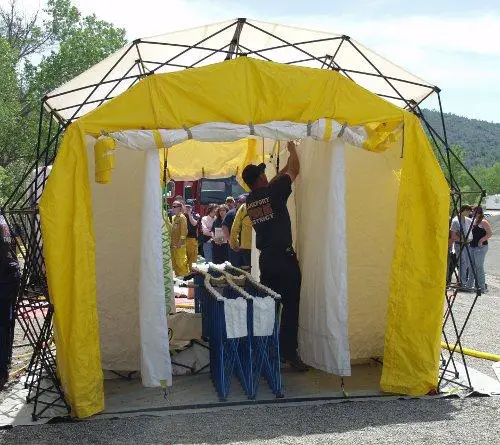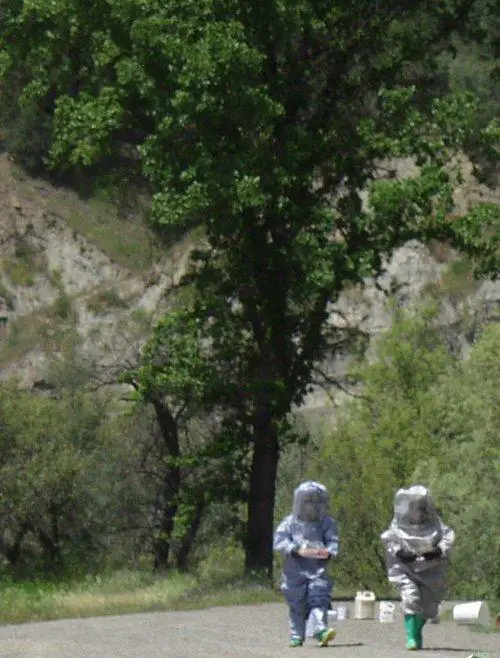
Lakeport Fire Protection Chief Ken Wells briefs participants in a hazmat exercise on Tuesday, May 4, 2010, east of Clearlake Oaks. Photo by Elizabeth Larson.
CLEARLAKE OAKS – On Tuesday local and state officials spent the day working through a practice disaster scenario in order to be prepared should the real thing happen someday.
The Lake County Sheriff’s Office of Emergency Services (OES) coordinated the full-scale hazardous materials exercise on the Clearlake Lava properties along Highway 20 east of Spring Valley from 9 a.m. to 2 p.m.
Officials said the annual disaster drills are designed to test Lake County's ability to respond, mitigate and recover from a hazardous materials incident or large-scale natural disaster.
The annual full-scale disaster exercises are mandated and funded through the Federal Department of Homeland Security, and are designed and facilitated by the Lake County Sheriff’s OES. They're meant to ensure proper response and management of real incidents and allow multiple agencies to work together in real time to practice solving a crisis in progress.
Lakeport Fire Chief Ken Wells was the day's incident commander, working with a unified command of officials with numerous local agencies.
Unified command members included Sgt. Gary Basor of the Lake County Sheriff's Office, Capt. Crystal Esberg and Jerry Wilson of Lake County OES, county Road Superintendent Steve Stangland, Dan Hernandez of Cal Fire and Dale Stoebe of Lakeport Police.
This was the third joint state and local exercise of its type conducted by the Lake County OES in as many years, according to Lake County OES. Other events included a mass casualty practice event at the county park in Upper Lake and another practice event at Blue Lakes.
Officials reported that the exercise had been in the planning stages since January, with the details kept confidential by exercise planners prior to the event in order for participant responders to experience and react to the incident as they would in an actual emergency.

A portable decontamination unit was set up and used on mock victims during the full-scale hazardous materials exercise on Tuesday, May 4, 2010, east of Clearlake Oaks. Photo by Elizabeth Larson.
The exercise involved the activation of more than 20 federal, state and local emergency resources, including more than 75 emergency responders from both Lake and Colusa counties.
Agencies participating in the Tuesday event included the Lake County Sheriff's Office, OES, Lakeport Fire Protection District, Northshore Fire Protection District, South Lake County Fire Protection District, Lake County Fire Protection District, Clearlake Police, Lakeport Police, Lake County Department of Public Works, Cal Fire, US Forest Service and Williams Fire, and the Environmental Health departments for both Lake and Colusa counties.
Stangland said the scenario for the practice emergency was a semi truck traveling through the county carrying a load of agricultural chemicals.
In the imagined scenario, the truck comes out of the mountains and onto the highway straightaway and loses several canisters of unidentified chemical materials. The truck driver continues on, apparently not realizing he's lost part of his load along the roadside.
Several mock victims – students with K-Corps – stop to pick up the materials and become contaminated. The scenario has four walking wounded and three people down, with a mock fatality resulting later in the exercise.
Responding to a situation involving hazardous materials requires careful planning and a systematic approach in order to keep everyone safe, Stangland said.
In the practice scenario, Wells was first on scene. He then had to use binoculars to get a sense of the situation, rather than directly entering it, in order to gauge the seriousness and call for the right response.
This year’s exercise also prompted a mock activation of the County Hazardous Materials Emergency Response Plan and full Operational Area activations, officials reported.

Personnel from area agencies suited up in hazmat gear in order to practice working with dangerous chemicals in a practice scenario on Tuesday, May 4, 2010, east of Clearlake Oaks. Photo by Elizabeth Larson.
Hazardous materials incidents are fairly common and generally easily managed and mitigated. However, Esberg said preparing for these types of incidents clearly demonstrates a mutual effort among state and local agencies to work together for a rapid and efficient response.
Part of the afternoon portion of the exercise involved trained hazmat investigators donning suits that can be worn for up to four hours before breaking down from chemicals. With the plastic suits pulled on over other protective gear and air tanks – which made them look like upright, walking turtles – the personnel approached the materials and collected them for identification.
The mock casualties then went through a decontamination unit, a tent with a warm shower system to help remove dangerous materials. The unit's bladder system catches the water for disposal. Wells said the tent unit is light enough to be carried by two people, and has a variety of hookups in order to be used different types of fire equipment.
Stangland said that the dispatch time on the practice event was 10:11 a.m. Within 33 minutes officials were on scene and addressing the hazmat event, a response time which Stangland said is “phenomenal” even for a practice scenario.
California Emergency Management Agency (CalEMA) officials were on scene to help evaluate the exercise and how the personnel performed.
CalEMA exercise planner Kevin Leisher and Tom Tornell, an operations planner, said the goal is to help people learn how better to respond to such situations in order to protect the public. Tornell said they seek to offer constructive criticism of the operation.

Personnel trained in hazmat set up an area to evaluate the chemicals found during the practice hazardous materials exercise on Tuesday, May 4, 2010, east of Clearlake Oaks. Photo by Elizabeth Larson.
Leisher said they evaluate the exercise based on the required tasks. They will then share those evaluations with Lake County Fire Protection District Battalion Chief Willie Sapeta, one of the day's organizers, who will then take about two to three weeks to complete an “after action report.”
In January Leisher worked with Lake County officials on a “tabletop” exercise in which they sat down together to talk through a scenario of communications inoperability in case of an emergency.
A member of a four-person coastal area team, Leisher also is working on an emergency practice scenario regarding port terrorism that's coming up in another part of the state. Over the next few years they'll be working on scenarios in other areas involving a massive Central Valley flood and a Northern California earthquake.
E-mail Elizabeth Larson at This email address is being protected from spambots. You need JavaScript enabled to view it.. Follow Lake County News on Twitter at http://twitter.com/LakeCoNews and on Facebook at http://www.facebook.com/pages/Lake-County-News/143156775604?ref=mf.

Fully protected personnel return from collecting samples from canisters left behind in the practice scenario in which a semi truck driver unknowingly loses part of a load of dangerous chemicals. Photo by Elizabeth Larson.

 How to resolve AdBlock issue?
How to resolve AdBlock issue? 











